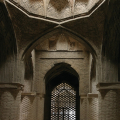MASJED-E DJOMEH (OR FRIDAY MOSQUE)
The mosque's double minaret forms the entrance of the streets of the bazaar. The very sober mosque on Friday, the only Persian to keep intact the buildings and sets of the seldjoukide periods (1051-1220), Ilkhanide (1220-1380), timouride (1370-1506), safavide (1570) 02-1736) and the most baroque turcoman, is a true museum of Islamic architecture of xie in the eighteenth century. Despite invasions, destruction, reconstructions, the ensemble retains a harmony and a wealth of styles that make it one of the most interesting monuments of the city. It is often called the old mosque by the inhabitants, in opposition to the Shah mosque, but the visit will convince you quickly that it has nothing to envy him!
To start your visit, focus on the exhibition of 3 D diagrams at the entrance, once passed the portal. They make it possible to fully realize the evolution of the building during successive dynasties and the construction or disappearance of its various parts.The Friday mosque of Ispahan remains the largest mosque in Iran, with 474 original individual vaults, and enjoys complex architecture mixing ages and styles. The remains of a first mosque with climate orientation dates back to the viiith century (773) and were erected under the Reign of the Abbassides. It was in the selfjoukide era that, on order of Vizir Nizâm al-Molk, in 1080, an exceptional dome in one vault was added according to the architectural principle of the fire temples. It must be said that Nizam al-Molk, Vizir of Malek Chah, had sworn to take his place and that the mosque had been completely destroyed by his supporters. The vizir for him ordered the construction of the north pole, prodiging architecture for the time. The two buildings from the conflict were the only ones surviving the great fire of the mosque in 1121.
It is in the southern part of the mosque that the main mirhab is found, but one of the most notable iwan is certainly that of the western flank, with its sefecal earthquakes. Also note the sobriety of the many vaulted brick rooms, surrounded by the central courtyard of four iwan dating back to the xiith century. The vault of the south iwan, the most impressive, is covered with large alveoli and superb ceramics of fatherhood of xvie, xviie and eighteenth centuries. On the north iwan side, the dervish iwan, the stars are made of the precise provision of bricks. The little tower of the West Iwan serves to call for prayer. On the right of this one, the small room of the Mongolian sultan Oldjaitou (whose mausoleum is in Soltaniyé) houses a very beautiful mihrab in 1310. Also admire the beautiful calligraphy and the finesse of carved flower motifs. Located in the basement, the Shabestan (summer and winter room), completed in 1447, stretches over 50 m long and 20 m wide. The low light filtered by the translucent algae algae ensured that all night was in prayer. Finally, you can close the visit of the Friday mosque through a tower of the annexes. The mosque actually housed madrasas (Koranic schools) and water rooms for the ablutions of the faithful.
After the visit, you will have embraced what successive Iranian architectural schools have produced more beautiful and more successful over the centuries!
Did you know? This review was written by our professional authors.
Members' reviews on MASJED-E DJOMEH (OR FRIDAY MOSQUE)
The ratings and reviews below reflect the subjective opinions of members and not the opinion of The Little Witty.






visitez Ispahan absolument